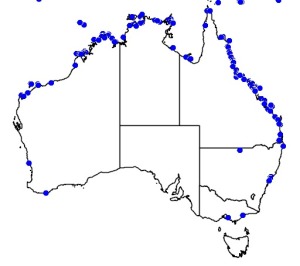�
�
�
���
Ellochelon vaigiensis
Diamondscale Mullet
Kingdom
Animalia
Phylum
Chordata
Class
Actinopterygii
Order
Mugiliformes
Family
Mugilidae
Genus
Ellochelon
Species
Ellochelon vaigiensis
Colours
Distinguishing features
A large silvery fish with a rounded snout, powerful tail, and distinct diamond scale pattern on the body. Small individuals have black pectoral fins. Usually seen in schools along rocky shores and over sandy or muddy bottoms.
Size
- Up to 55 cm (Standard length)
Depth range
- Depth range data is not yet available.
Synonyms
Distribution
Distribution and habitat preferences
Usually found in schools over shallow sandy, muddy or rubble bottoms in sheltered parts of the Island. Regularly seen off Research Beach and Mangrove Beach.
Can be found in most sheltered locations around the island.
Behaviour
This species feeds on plankton and detritus, and the fish move quickly across the bottom slurping up sediment. They aggregate in large schools to spawn in deeper offshore water during the mid-summer months of December to February. This species probably lives to about 10 years.
Web resources
References
References that assist with identification
- Allen, G., R. Steene, P. Humann and N. Deloach (2003). Reef fish identification: Tropical Pacific New World Publications Inc., Jacksonville, FL, USA.
- Randall, J.E., G.R. Allen and R.C. Steene (1990). Fishes of the Great Barrier Reef and Coral Sea University of Hawaii Press, Honolulu, Hawaii.
Other references
- Grant, C.J. and A.V. Spain (1975). Reproduction, Growth and Size Allometry of Liza vaigiensis (Quoy and Gaimard) (Pisces: Mugilidae) from North Queensland Inshore Waters, Australian Journal of Zoology, 23: 475-85. LIRS catalog number 90070.
- View all references



